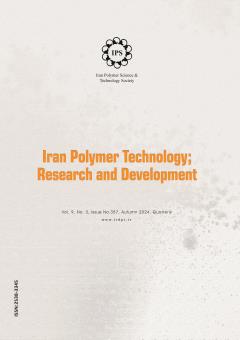A review of the physical mixing method to prevent fouling in polymer membranes
Subject Areas : پلیمرها در انرژی و کاربردهای بهداشتی و محیطیAmir Kholghi 1 , Morteza Nasiri 2
1 - Sahand University of Technology - Faculty of Polymer
2 -
Keywords: Phase separation, Fouling, Anti-fouling materials, Physical mixing,
Abstract :
Membrane technology is an essential tool for purification and separation of liquid, solid and gas solutions, which is used in a wide range of industrial and medical applications. Despite being widely used in these fields, polymer-based membranes still face several challenges, including instability, low mechanical strength, and tendency to fouling. The last point has attracted the attention of many research groups around the world. A convenient method for preparing antifouling membranes is through physical mixing, which is a one-step method that involves mixing the base polymer and antifouling materials before casting and forming a film by a phase separation process. This review focuses on the recent development of anti-fouling membranes through this method and initially deals with different phase separation processes including non-solvent induced phase separation, vapor induced phase separation, temperature induced phase separation evaporation induced phase separation. In this study, the application of polymer anti-fouling materials such as nanocellulose, hydrophilic polymers, sulfonated polymers, amphiphilic block copolymers, etc., to achieve anti-fouling properties and improve the performance of the resulting membranes from the point of view of pure water flux, rejection percentage and flux recovery rate are investigated. The results of this study show that physical mixing with appropriate antifouling materials is an effective method to reduce the amount of fouling and improve the performance of membranes.
1. Baker, R. Membrane Technology and Applications, 2nd ed.; John Wiley & Sons, Ltd.: Hoboken, NJ, USA, 2004.
2. Ezugbe, E.O.; Rathilal, S. Membrane Technologies in Wastewater Treatment: A Review. Membranes, 10, 89,2020.
3. Zhang, R.; Liu, Y.; He, M.; Su, Y.; Zhao, X.; limelech, M.; Jiang, Z. Antifouling membranes for sustainable water purification: Strategies and mechanisms. Chem. Soc. Rev., 45, 5888–5924,2016.
4. Li, Chengcai, et al. "Graphene oxide incorporated thin film nanocomposite nanofiltration membrane to enhance permeation and antifouling properties." Desalination and Water Treatment 317، 2024.
5. Desiriani, Ria, et al. "Preparation of polyethersulfone ultrafiltration membrane coated natural additives toward antifouling and antimicrobial agents for surface water filtration." Journal of Environmental Chemical Engineering, 12, 111797, 2024.
6. Yuan, X.S.; Liu, W.; Zhu, W.Y.; Zhu, X.X. Enhancement in Flux and Antifouling Properties of Polyvinylidene Fluoride/Polycarbonate Blend Membranes for Water Environmental Improvement. ACS Omega, 5, 30201–30209,2020.
7. Mu, Y.; Feng, H.; Wang, S.; Zhang, S.; Luan, J.; Zhang, M.; Yu, Z.; Wang, G. Combined strategy of blending and surface modification as an effective route to prepare antifouling ultrafiltration membranes.J. Colloid Interface Sci., 589, 1–12, 2021.
8. Li, X.; Cao, Y.; Kang, G.; Yu, H.; Jie, X.; Yuan, Q. Surface modification of polyamide nanofiltration membrane by grafting zwitterionic polymers to improve the antifouling property. J. Appl. Polym. Sci., 131, 1–9, 2014.
9. Danner, Joseph T., et al. "2-Methylpyrazine: A Greener Solvent for Nonsolvent Induced Phase Separation (NIPS) Membrane Fabrication." Industrial & Engineering Chemistry Research (2024).
10. Li K, Krantz W, Greenberg A, Sani R, Membrane formation via thermally induced phase separation (TIPS): model development and validation. J Membr Sci 279:50–60, 2006.
11. GHASEMI, S.M; KHOLGHI, A. Porous films prepared from poly (styrene-co-acrylonitrile)/dichloromethane system via evaporation induced phase separation: Structure-thermodynamic aspects. Progress in Organic Coatings, 168: 106885, 2022.
12. Venault A, Chang Y, Wang D-M, Bouyer D A review on polymeric membranes and hydrogels prepared by vapor induced phase separation process. Polym Rev 53(4):568–626, 2013.
13. Figoli A, Marino T, Galiano F In: Figoli A, Cassano A, Basile A (eds) Membrane technologies for biorefining. Woodhead Publishing, Cambridge, pp 29–59, 2016.
14. Padaki M, Surya Murali R, Abdullah MS, Misdan N, Moslehyani A, Kassim MA, Hilal N, Ismail AF Membrane technology enhancement in oil–water separation. A review. Desalination,357:197–207, 2015.
15. Koros WJ, Ma YH, Shimidzu T Terminology for membranes and membrane processes (IUPAC Recommendations1996). Pure Appl Chem, 1996.
16. Saleh TA, Gupta VK Membrane fouling and strategies for cleaning and fouling control. In: Saleh TA, Gupta VK (eds) Nanomaterial and polymer membranes. Elsevier, Amsterdam, pp 25–53, 2016.
17. Alvarado C, Farris K, Kilduff J Membrane fouling, modelling and recent developments for mitigation. In: Hankins NP, Singh R (eds) Emerging membrane technology for sustainable water treatment. Elsevier, Amsterdam, pp 433–462, 2016.
18. Guo W, Ngo H-H, Li J A mini-review on membrane fouling. Biores Technol 122:27–34, 2012.
19. Iritani E A review on modeling of pore-blocking behaviors of membranes during pressurized membrane filtration, Drying Technol 31(2):146–162, 2013.
20. Castro-Muñoz R, Boczkaj G, Gontarek E, Cassano A, Fíla V Membrane technologies assisting plant-based and agrofood by-products processing: a comprehensive review. Trends Food Sci Technol 95:219–232, 2020.
21. Cassano A, Conidi C, Ruby-Figueroa R, Castro-Muñoz R Nanofiltration and tight ultrafiltration membranes for the recovery of polyphenols from agro-food by-products. Int J Mol Sci, 2018.
22. Pichardo-Romero DG-A, Garcia-Arce ZP, Zavala-Ramírez A, Castro-Muñoz R Current advances in biofouling mitigation in membranes for water treatment: an overview. Processes8:182, 2020.
23. Wu, Zixuan, et al. "Nanocelluloses fine-tuned polyvinylidene fluoride (PVDF) membrane for enhanced separation and antifouling." Carbohydrate Polymers 323, 121383, 2024.
24. Febriasari, A., Huriya, Ananto, A. H., Suhartini, M., & Kartohardjono, S., Polysulfone–polyvinyl pyrrolidone blend polymer composite membranes for batik industrial wastewater treatment. Membranes, 11(1), 66, 2021.
25. Wen, Xin, et al. "Fabrication of an antifouling PES ultrafiltration membrane via blending SPSF." RSC advances 12.3، 1460-1470, 2022.
26. Khan, Raja Muhammad Asif, et al. "Ultrafiltration polyanionic poly (3‐sulfopropyl methacrylate) membranes with enhanced antifouling and water flux." Polymers for Advanced Technologies 35, e6350, 2024.
27. Yong, Ming, et al. "Properties of polyvinyl chloride (PVC) ultrafiltration membrane improved by lignin: Hydrophilicity and antifouling." Journal of membrane science 575،50-59, 2019.
28. Khosroshahi, M. Monsefi, et al. "Novel polyvinyl chloride ultrafiltration membranes blended with amphiphilic polyethylene glycol-block-poly (1, 2-dichloroethylene) copolymer for oily wastewater treatment." Journal of Water Process Engineering 56, 104433, 2023.
